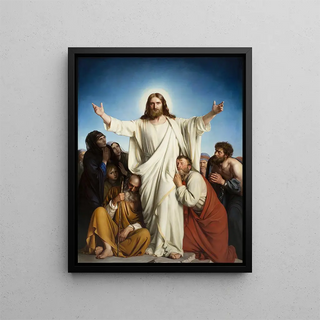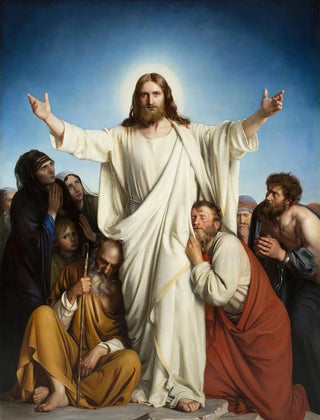Painting The Christ Consoler - Carl Bloch | Art print


View from behind

Frame (optional)
In the realm of religious art, some works transcend the mere pictorial framework to offer a truly spiritual experience. "The Comforting Christ" by Carl Bloch is a perfect example. This piece, imbued with tenderness and compassion, invites the viewer to an introspective contemplation. The depiction of Christ, enveloped in warm light, seems to speak directly to the soul, bringing comfort and hope. The scene, both intimate and universal, touches sensitive chords, recalling the quest for inner peace that each of us seeks. Entering this painting transports one to a suspended moment where the divine and the human meet with poignant intensity.
Style and uniqueness of the work
Carl Bloch, master of 19th-century religious painting, manages to capture the very essence of compassion through his unique style. "The Comforting Christ" stands out for its soft colors and harmonious composition. The subtle play of light, illuminating the face of Christ, creates an atmosphere of serenity and warmth. The meticulous details of the clothing and the expressions of the characters add emotional depth to the piece. Bloch excels in depicting human emotions, and here, every gaze, every gesture, seems charged with meaning. This painting does not merely tell a story; it evokes deep feelings, immersing the viewer in a silent dialogue with the divine. The artist's mastered technique, blending realism and spirituality, makes this work a true masterpiece.
The artist and his influence
Carl Bloch, born in Denmark in 1834, established himself as one of the most influential artists of his time, notably through his religious works. His training at the Royal Danish Academy of Fine Arts in Copenhagen allowed him to develop a style that combines tradition and innovation. Bloch was deeply inspired by the great masters of the past, while infusing modernity into his creations. His work had a significant impact on religious painting, redefining the codes of sacred representation. Beyond his talents as a painter, Bloch was also a passionate advocate of

Matte finish

View from behind

Frame (optional)
In the realm of religious art, some works transcend the mere pictorial framework to offer a truly spiritual experience. "The Comforting Christ" by Carl Bloch is a perfect example. This piece, imbued with tenderness and compassion, invites the viewer to an introspective contemplation. The depiction of Christ, enveloped in warm light, seems to speak directly to the soul, bringing comfort and hope. The scene, both intimate and universal, touches sensitive chords, recalling the quest for inner peace that each of us seeks. Entering this painting transports one to a suspended moment where the divine and the human meet with poignant intensity.
Style and uniqueness of the work
Carl Bloch, master of 19th-century religious painting, manages to capture the very essence of compassion through his unique style. "The Comforting Christ" stands out for its soft colors and harmonious composition. The subtle play of light, illuminating the face of Christ, creates an atmosphere of serenity and warmth. The meticulous details of the clothing and the expressions of the characters add emotional depth to the piece. Bloch excels in depicting human emotions, and here, every gaze, every gesture, seems charged with meaning. This painting does not merely tell a story; it evokes deep feelings, immersing the viewer in a silent dialogue with the divine. The artist's mastered technique, blending realism and spirituality, makes this work a true masterpiece.
The artist and his influence
Carl Bloch, born in Denmark in 1834, established himself as one of the most influential artists of his time, notably through his religious works. His training at the Royal Danish Academy of Fine Arts in Copenhagen allowed him to develop a style that combines tradition and innovation. Bloch was deeply inspired by the great masters of the past, while infusing modernity into his creations. His work had a significant impact on religious painting, redefining the codes of sacred representation. Beyond his talents as a painter, Bloch was also a passionate advocate of
12,34 €






